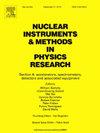Application of electronic time focusing at the engineering materials diffractometer in the China spallation neutron source
IF 1.5
3区 物理与天体物理
Q3 INSTRUMENTS & INSTRUMENTATION
Nuclear Instruments & Methods in Physics Research Section A-accelerators Spectrometers Detectors and Associated Equipment
Pub Date : 2024-11-14
DOI:10.1016/j.nima.2024.170080
引用次数: 0
Abstract
The Engineering Materials Diffractometer (EMD) is a new and critical addition to the instrument suite of the China Spallation Neutron Source (CSNS). It will support extensive research activities and applications on modern engineering materials. Based on the large multielement detector array, the electronic time focusing method has been successfully applied to deal with the raw neutron data and the constants Ci, corresponding to each single pixel in the detector array, have been calculated using the relation between the time of flight of the Bragg peaks in standard Si sample and their particular d-spacings. The instrument resolution in the mode best suited for strain measurements (∼0.35%) is interpreted and verified as a function of d-spacing via Si and La11B6 standard samples. The results are found to be consistent with the McStas simulations of the instrument physical design.
电子时间聚焦在中国溅射中子源工程材料衍射仪上的应用
工程材料衍射仪(EMD)是中国溅射中子源(CSNS)新添的重要仪器。它将为现代工程材料的广泛研究活动和应用提供支持。在大型多元素探测器阵列的基础上,成功应用电子时间聚焦法处理原始中子数据,并利用标准 Si 样品中布拉格峰的飞行时间与其特定 d 间距之间的关系,计算出探测器阵列中每个单像素对应的常数 Ci。通过硅和 La11B6 标准样品,解释并验证了最适合应变测量模式(∼0.35%)下的仪器分辨率与 d 间距的函数关系。结果与仪器物理设计的 McStas 模拟一致。
本文章由计算机程序翻译,如有差异,请以英文原文为准。
求助全文
约1分钟内获得全文
求助全文
来源期刊
CiteScore
3.20
自引率
21.40%
发文量
787
审稿时长
1 months
期刊介绍:
Section A of Nuclear Instruments and Methods in Physics Research publishes papers on design, manufacturing and performance of scientific instruments with an emphasis on large scale facilities. This includes the development of particle accelerators, ion sources, beam transport systems and target arrangements as well as the use of secondary phenomena such as synchrotron radiation and free electron lasers. It also includes all types of instrumentation for the detection and spectrometry of radiations from high energy processes and nuclear decays, as well as instrumentation for experiments at nuclear reactors. Specialized electronics for nuclear and other types of spectrometry as well as computerization of measurements and control systems in this area also find their place in the A section.
Theoretical as well as experimental papers are accepted.

 求助内容:
求助内容: 应助结果提醒方式:
应助结果提醒方式:


